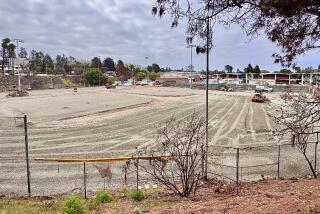Criticism of Belmont Project Is Unfounded
- Share via
When I was first elected to the Los Angeles Unified School District board in 1993, the district transported nearly 1,000 students from an area just west of downtown to neighborhoods as far away and unknown to them as Verdugo Hills and Woodland Hills. Built in 1923 and the only senior high in their community, the existing Belmont High School had to turn away these local students due to severe overcrowding. Given this situation, it was imperative that we build a new school--one that would serve as an educational model by offering four career centers, each of which would allow students the opportunity to home in on a specific academic field, including engineering, business and government. The career centers later became the basis for the Belmont Learning Complex.
Now, with parts of the project already built, construction on Belmont continues despite reports to the contrary. The school district has weathered considerable criticism about the project, much of which is unfounded and a result of a mistaken belief that earlier investigations of the Belmont property were either grossly inadequate or simply not done. For starters, the Belmont site was not purchased with a blind eye to the region’s environmental conditions, namely, the existence of an oil field on portions of the school property. The oil field, considered by many to be an environmental threat, is one of several oil fields currently situated beneath residences, hospitals and schools in many parts of the Southland, including Beverly Hills and Century City. In planning to build the campus, we made a deliberate choice to locate Belmont school buildings south of the oil field, not over it.
We were not naive about the costs of building a school in downtown Los Angeles. In dense, urban Los Angeles, land is not cheap and environmental cleanup is hardly uncommon. But you put schools where they are most needed. Before acquiring the 24-acre section of the project that later became the hub of the school campus, the district and the prior owner of the property conducted a preliminary environmental assessment, which recommended more extensive testing to help better comprehend the site’s contaminants and oil production uses. Borings, soil samples and other invasive tests were performed in both 1989 and 1994, and the state’s Division of Oil, Gas and Geothermal Resources informed us as early as 1993 that a methane protection system would be necessary to prevent the odorless gas from accumulating beneath school buildings.
Despite numerous media accounts of recently discovered chemicals, small amounts of contaminants such as benzene and xylene have long been known to exist at the site.
Between 1994 and the beginning of construction in August 1997, environmental specialists were hired to locate and close oil wells under the auspices of the state’s Division of Oil and Gas. Contaminated soils were excavated and removed, underground storage tanks were hauled off after receiving city Fire Department approval, and a geophysical survey was completed.
The district addressed the principal areas of concern at the site: the active and inactive oil wells and the pocket of former automotive facilities’ waste at the southern tip of the property. This was well known by the time the district began to pour concrete slabs and erect structural footings.
But the Belmont Learning Complex, an already controversial project, soon found itself back in the limelight last fall after the superintendent announced that the state’s Department of Toxic Substances Control would oversee all future and existing school construction projects. After a middle school in South-Central Los Angeles nearly closed due to environmental concerns, the district sought a new watchdog for assessing potential school sites. Rather than rely on internal guidelines and a patchwork of regulatory agencies to direct our environmental studies, we recognized the value of having one state agency oversee our activities.
Among other findings, the state told us that we need more information about the site’s methane conditions. Further, even though most of the Belmont property was formerly residential, all locations within the property have to be probed and tested, regardless of their prior use. Our environmental experts conducting the tests have seen nothing to date that suggests that this educational resource will not be built and occupied by students. I am proud of the efforts we have undertaken to provide a new high school in a community that has for too long seen its children board buses.
And I am increasingly confident that, after the television cameras fade away and critics of the project move on to other issues, we will be left with something wonderful: a hallmark of learning that challenges, educates and enriches the lives of 5,000 students.
More to Read
Sign up for Essential California
The most important California stories and recommendations in your inbox every morning.
You may occasionally receive promotional content from the Los Angeles Times.













